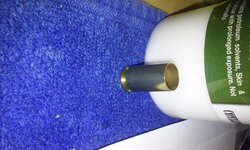- Messages
- 87
- Reactions
- 103
Just thought I'd give a little update on my trial and tribulations of getting into reloading and some of what I have learned. I know enough right now (as all n00bs do) to be dangerous as with any new hobby, we kind of get the mentality that this is so easy even a caveman could do it. I have not had any mishaps (knock on wood) but I do check ALL test loads. As for my 40 Smith & Wesson that I just had a feeling about, nothing really stood out as the cases looked fine but when I ran them through the case checker (which I do all my ammo that I make) I found a surprise that not all ammo that we produce it's going to work for some reason or another.
5 out of 50 did not gauge so they were pulled, measured & inspected to find that they must be caused by bullet misalignment because the cases themselves were within specs.
One of the nogo rounds did pass when turning it while in the gauge.
Pics tell the tale.
Thoughts?
View attachment 348191 View attachment 348192
I don't use a Lee, I use a Dillon, but in my Dillon seating die there is a little dingus inside that can be rotated using one side if you are using flat nosed or hollow point bullets, and the other side if you are using round nosed bullets. Using the wrong side can affect bullet seating. Maybe the Lee die has something similar?













